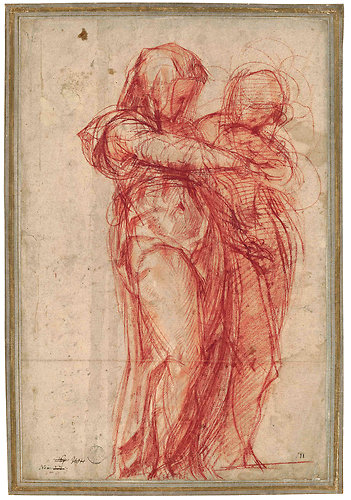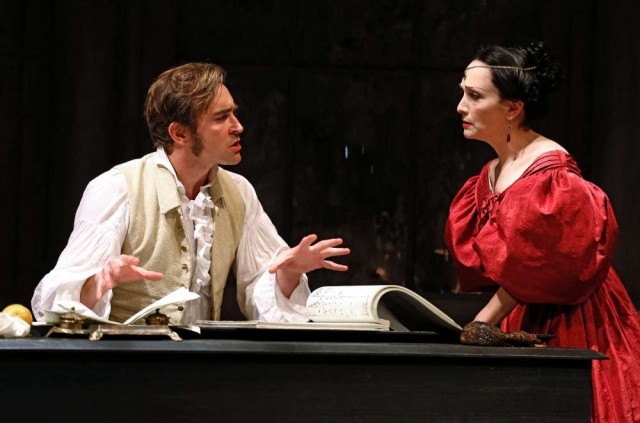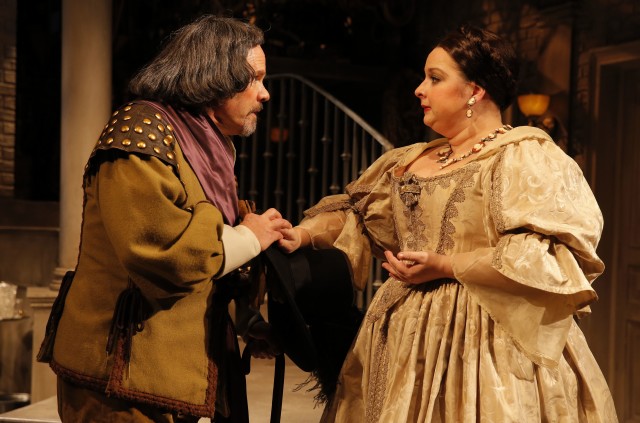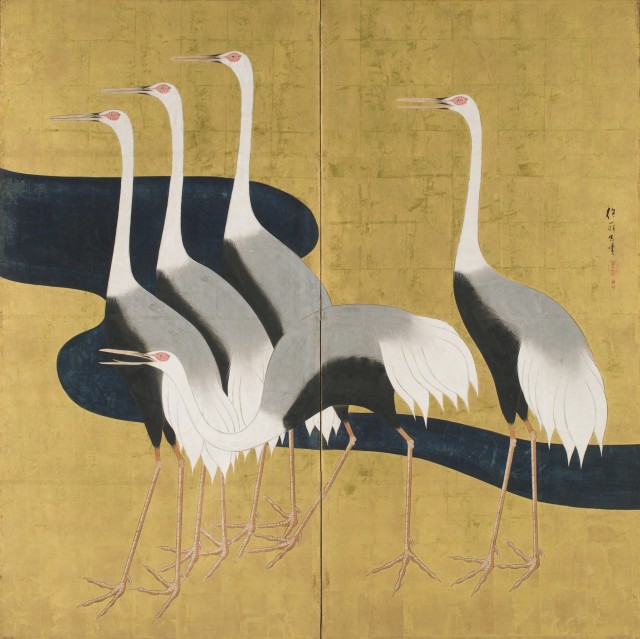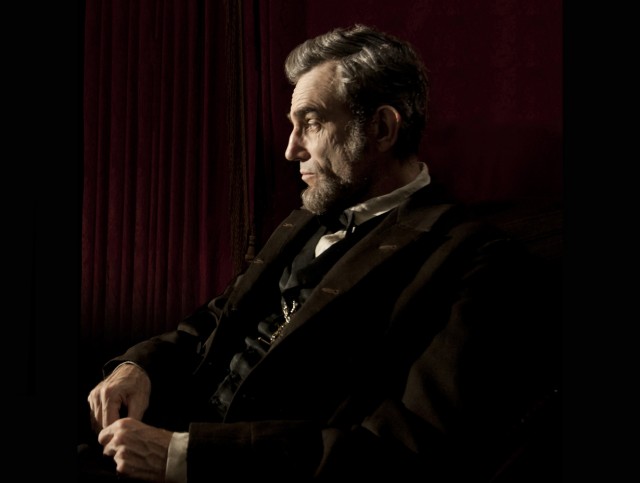
Daniel Day-Lewis gives a magnificent performance as the sixteenth president of the United States in Steven Spielberg’s LINCOLN
LINCOLN (Steven Spielberg, 2012)
In theaters now
www.thelincolnmovie.com
 Over the years, a handful of fine actors have portrayed Abraham Lincoln, including Walter Huston in D. W. Griffiths’s 1930 Abraham Lincoln, Henry Fonda in John Ford’s 1939 Young Mr. Lincoln, Raymond Massey in John Cromwell’s 1940 Abe Lincoln in Illinois, and Emmy winner Hal Holbrook in the 1974 miniseries Sandburg’s Lincoln, as well as George A. Billings in Phil Rosen’s 1924 The Dramatic Life of Abraham Lincoln and Benjamin Walker in Timur Bekmambetov’s 2012 Abraham Lincoln: Vampire Hunter. But no one has ever quite captured the essence of the sixteenth president of the United States of America as Daniel Day-Lewis does in Steven Spielberg’s Lincoln. Day-Lewis is mesmerizing as Lincoln, a tall, goodhearted soul trying to end slavery and the Civil War. Based on Doris Kearns Goodwin’s 2005 book, Team of Rivals: The Political Genius of Abraham Lincoln, the film begins in January 1865, as newly reelected Honest Abe is caught in a tenuous situation: He can work to pass the Thirteenth Amendment, which would abolish slavery, or meet with a contingent from the South (which includes Jackie Earle Haley as Confederate vice president Alexander H. Stephens) to reach a peaceful settlement, but it is unlikely he can do both. Secretary of State William H. Seward (David Strathairn) wants him to forget about the amendment, believing passage in the House of Representatives would be impossible, but Lincoln is determined to do what is right, even if it takes a trio of shady lobbyists (James Spader, John Hawkes, and Tim Blake Nelson) to help get it done. Spielberg and screenwriter Tony Kushner (Angels in America) depict Lincoln as a careful, caring man who loves going off on tangents, telling stories, parables, and even dirty jokes. He lies on the floor with his young son, Tad (Gulliver McGrath), tries to calm his wife, Mary (Sally Field), whom he calls Molly and is still haunted by the death of their son Willy, and attempts to convince their older son, Robert (Joseph Gordon-Levitt), not to join the Union Army. Day-Lewis plays Lincoln as a strong yet fragile man torn apart on the inside much like the country is torn apart over the issue of slavery — as shown particularly in the House, where radical Republican leader Thaddeus Stevens (Tommy Lee Jones) is enjoying a vicious battle of words with Democratic standard-bearer Fernando Wood (Lee Pace) that is every bit as contentious as the current Congress. The uniformly fine cast, filled with stage veterans, also includes Holbrook as Francis Preston Blair, Jared Harris as Ulysses S. Grant, Michael Stuhlbarg as George Yeaman, Colman Domingo as Harold Green, Stephen McKinley Henderson as William Slade, Walton Goggins as Wells A. Hutchins, Gregory Itzin as John Archibald Campbell, and Stephen Spinella as Asa Vintner Litton. Unfortunately, Spielberg can’t leave well enough alone, pulling at the heartstrings with an unnecessary opening sequence and a tragically overwrought finale; without those scenes, Lincoln had a chance to become a classic; with them, it is merely a solid film that sheds fascinating new light on a critical moment in U.S. history, portrayed by a master craftsman with immense skill, the first actor to completely disappear into the part of this genuine American hero.
Over the years, a handful of fine actors have portrayed Abraham Lincoln, including Walter Huston in D. W. Griffiths’s 1930 Abraham Lincoln, Henry Fonda in John Ford’s 1939 Young Mr. Lincoln, Raymond Massey in John Cromwell’s 1940 Abe Lincoln in Illinois, and Emmy winner Hal Holbrook in the 1974 miniseries Sandburg’s Lincoln, as well as George A. Billings in Phil Rosen’s 1924 The Dramatic Life of Abraham Lincoln and Benjamin Walker in Timur Bekmambetov’s 2012 Abraham Lincoln: Vampire Hunter. But no one has ever quite captured the essence of the sixteenth president of the United States of America as Daniel Day-Lewis does in Steven Spielberg’s Lincoln. Day-Lewis is mesmerizing as Lincoln, a tall, goodhearted soul trying to end slavery and the Civil War. Based on Doris Kearns Goodwin’s 2005 book, Team of Rivals: The Political Genius of Abraham Lincoln, the film begins in January 1865, as newly reelected Honest Abe is caught in a tenuous situation: He can work to pass the Thirteenth Amendment, which would abolish slavery, or meet with a contingent from the South (which includes Jackie Earle Haley as Confederate vice president Alexander H. Stephens) to reach a peaceful settlement, but it is unlikely he can do both. Secretary of State William H. Seward (David Strathairn) wants him to forget about the amendment, believing passage in the House of Representatives would be impossible, but Lincoln is determined to do what is right, even if it takes a trio of shady lobbyists (James Spader, John Hawkes, and Tim Blake Nelson) to help get it done. Spielberg and screenwriter Tony Kushner (Angels in America) depict Lincoln as a careful, caring man who loves going off on tangents, telling stories, parables, and even dirty jokes. He lies on the floor with his young son, Tad (Gulliver McGrath), tries to calm his wife, Mary (Sally Field), whom he calls Molly and is still haunted by the death of their son Willy, and attempts to convince their older son, Robert (Joseph Gordon-Levitt), not to join the Union Army. Day-Lewis plays Lincoln as a strong yet fragile man torn apart on the inside much like the country is torn apart over the issue of slavery — as shown particularly in the House, where radical Republican leader Thaddeus Stevens (Tommy Lee Jones) is enjoying a vicious battle of words with Democratic standard-bearer Fernando Wood (Lee Pace) that is every bit as contentious as the current Congress. The uniformly fine cast, filled with stage veterans, also includes Holbrook as Francis Preston Blair, Jared Harris as Ulysses S. Grant, Michael Stuhlbarg as George Yeaman, Colman Domingo as Harold Green, Stephen McKinley Henderson as William Slade, Walton Goggins as Wells A. Hutchins, Gregory Itzin as John Archibald Campbell, and Stephen Spinella as Asa Vintner Litton. Unfortunately, Spielberg can’t leave well enough alone, pulling at the heartstrings with an unnecessary opening sequence and a tragically overwrought finale; without those scenes, Lincoln had a chance to become a classic; with them, it is merely a solid film that sheds fascinating new light on a critical moment in U.S. history, portrayed by a master craftsman with immense skill, the first actor to completely disappear into the part of this genuine American hero.
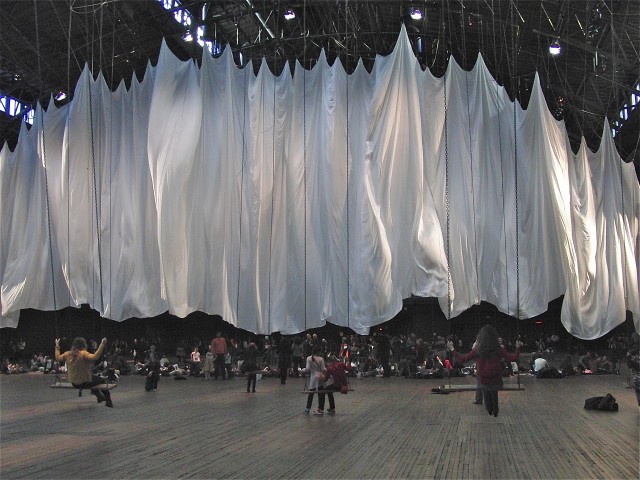
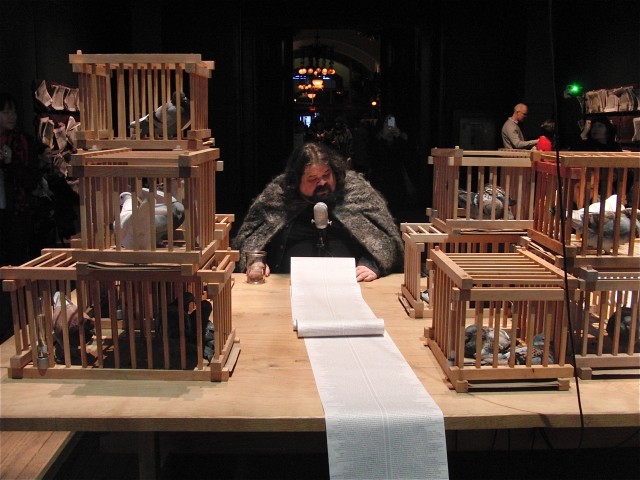
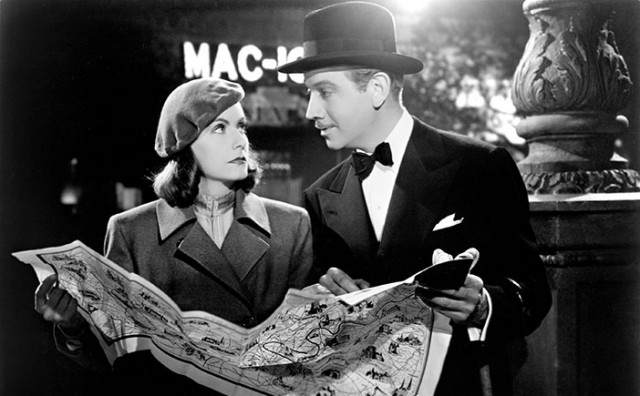
 Greta Garbo laughs — and says she doesn’t want to be alone — in Ernst Lubitsch’s classic pre-Cold War comedy Ninotchka, currently showing in a new 35mm print at Film Forum through January 3. In her next-to-last film, Garbo is sensational as Nina Ivanovna “Ninotchka” Yakushova, a Russian envoy sent to Paris to clean up a mess left by three comrade stooges, Iranov (Sig Ruman), Buljanov (Felix Bressart), and Kopalsky (Alexander Granach). The hapless trio from the Russian Trade Board had been sent to France to sell jewelry previously owned by the Grand Duchess Swana (Ina Claire) and now in the possession of the government following the 1917 Russian Revolution. But the duchess’s lover, Count Léon d’Algout (Melvyn Douglas), gets wind of the plan and attempts to break up the deal while also introducing the three men to the many decadent pleasures of a free, capitalist society. Then in waltzes the stern, by-the-book Ninotchka, who wants to set the Russian men straight, as well as Léon. “As basic material, you may not be bad,” she tells him atop the Eiffel Tower, “but you are the unfortunate product of a doomed culture.” At first, Ninotchka speaks robotically, spouting the company line, but she loosens up considerably once Léon shows her what communism has been depriving her of, yet it’s difficult for her to turn her back on the cause, leading to numerous hysterical conversations — the razor-sharp script was written by Charles Brackett, Walter Reisch, and Billy Wilder, based on a story by Melchior Lengyel — that serve as both a battle of the sexes and social commentary on the Russian and French ways of life. “I’ve heard of the arrogant male in capitalistic society. It is having a superior earning power that makes you that way,” Ninotchka tells Léon shortly after meeting him on a Paris street. “A Russian! I love Russians! Comrade, I’ve been fascinated by your Five-Year Plan for the last fifteen years,” Léon responds, to which Ninotchka tersely replies, “Your type will soon be extinct.” Nominated for four Academy Awards, including Best Picture, Best Actress, Best Original Story, and Best Screenplay, Ninotchka is one of the most delightful romantic comedies ever made, filled with little surprises every step of the way (including a serious cameo by Bela Lugosi), serving up a blueprint that has been followed by so many films for nearly three-quarters of a century ever since.
Greta Garbo laughs — and says she doesn’t want to be alone — in Ernst Lubitsch’s classic pre-Cold War comedy Ninotchka, currently showing in a new 35mm print at Film Forum through January 3. In her next-to-last film, Garbo is sensational as Nina Ivanovna “Ninotchka” Yakushova, a Russian envoy sent to Paris to clean up a mess left by three comrade stooges, Iranov (Sig Ruman), Buljanov (Felix Bressart), and Kopalsky (Alexander Granach). The hapless trio from the Russian Trade Board had been sent to France to sell jewelry previously owned by the Grand Duchess Swana (Ina Claire) and now in the possession of the government following the 1917 Russian Revolution. But the duchess’s lover, Count Léon d’Algout (Melvyn Douglas), gets wind of the plan and attempts to break up the deal while also introducing the three men to the many decadent pleasures of a free, capitalist society. Then in waltzes the stern, by-the-book Ninotchka, who wants to set the Russian men straight, as well as Léon. “As basic material, you may not be bad,” she tells him atop the Eiffel Tower, “but you are the unfortunate product of a doomed culture.” At first, Ninotchka speaks robotically, spouting the company line, but she loosens up considerably once Léon shows her what communism has been depriving her of, yet it’s difficult for her to turn her back on the cause, leading to numerous hysterical conversations — the razor-sharp script was written by Charles Brackett, Walter Reisch, and Billy Wilder, based on a story by Melchior Lengyel — that serve as both a battle of the sexes and social commentary on the Russian and French ways of life. “I’ve heard of the arrogant male in capitalistic society. It is having a superior earning power that makes you that way,” Ninotchka tells Léon shortly after meeting him on a Paris street. “A Russian! I love Russians! Comrade, I’ve been fascinated by your Five-Year Plan for the last fifteen years,” Léon responds, to which Ninotchka tersely replies, “Your type will soon be extinct.” Nominated for four Academy Awards, including Best Picture, Best Actress, Best Original Story, and Best Screenplay, Ninotchka is one of the most delightful romantic comedies ever made, filled with little surprises every step of the way (including a serious cameo by Bela Lugosi), serving up a blueprint that has been followed by so many films for nearly three-quarters of a century ever since.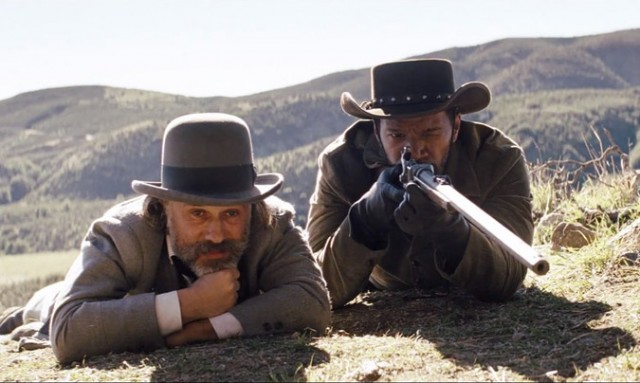
 Multigenre master Quentin Tarantino, who as writer-director has taken on the gangster film (Reservoir Dogs), pulp movies (Pulp Fiction), Blaxploitation (Jackie Brown), the martial arts (Kill Bill, Vols. I & II), grindhouse (Death Proof), and WWII (Inglourious Basterds) with nearly universally acclaimed results, has now turned his attention to the spaghetti Western, resulting in yet another awesome achievement. A Southern Western that in many ways is the black version of Inglourious Basterds, Django Unchained is set immediately before the Civil War, as bounty hunter and former dentist King Schultz (Oscar winner Christoph Waltz) obtains a slave named Django (Oscar and Grammy winner Jamie Foxx) in order to track down the wanted Brittle brothers (Cooper Huckabee, Doc Duhame, and M. C. Gainey) and collect a substantial reward. Schultz has promised Django his freedom and some cash in return for his assistance, but the two stick together as they go off in search of Django’s wife, Broomhilda Von Shaft (Kerry Washington), who was brutally taken away from him and now works on the Candyland plantation owned by the slick, smooth Calvin J. Candie (Leonardo DiCaprio) and run by an Uncle Tom slave known as Stephen (Samuel L. Jackson). As with most Tarantino films, things get a little violent by the end, an operatic barrage of blood and guts that would make Sam Peckinpah proud. Tarantino, who appeared in Takashi Miike’s 2007 Sukiyaki Western Django and plays a small part here as well, continues his reign as the King of the Revenge Film with Django Unchained, another movie that is, at its heart, another celebration of movies themselves. Tarantino masterfully toys with cinematic conventions, tongue often firmly in cheek, evoking a stream of Western classics, including The Wild Bunch, The Searchers, Blazing Saddles, and, of course, Sergio Corbucci’s 1966 Django — he even gives a small part to Franco Nero, who played the title role in the Corbucci flick. Tarantino also adds beautifully absurd humor, primarily in the form of a riotous scene with masked marauders, a perhaps overly liberal use of the N-word, a vast array of familiar faces rounding out the cast (Don Johnson, Dennis Christopher, Bruce Dern, Tom Wopat, James Russo, Jonah Hill, Robert Carradine, and James Remar inexplicably in two roles), and, as usual, a killer soundtrack, ranging from new music by Ennio Morricone, John Legend, and Anthony Hamilton to a spectacularly out-of-place song by the late Jim Croce. He even references German literature in the form of the famous myth of Siegfried and Brunhilde. Yes, the film is too long, too violent, and too filled with stereotypes, and the story comes together a little too easily, but heck, it’s still about as much fun as you’re gonna have at the movies this year.
Multigenre master Quentin Tarantino, who as writer-director has taken on the gangster film (Reservoir Dogs), pulp movies (Pulp Fiction), Blaxploitation (Jackie Brown), the martial arts (Kill Bill, Vols. I & II), grindhouse (Death Proof), and WWII (Inglourious Basterds) with nearly universally acclaimed results, has now turned his attention to the spaghetti Western, resulting in yet another awesome achievement. A Southern Western that in many ways is the black version of Inglourious Basterds, Django Unchained is set immediately before the Civil War, as bounty hunter and former dentist King Schultz (Oscar winner Christoph Waltz) obtains a slave named Django (Oscar and Grammy winner Jamie Foxx) in order to track down the wanted Brittle brothers (Cooper Huckabee, Doc Duhame, and M. C. Gainey) and collect a substantial reward. Schultz has promised Django his freedom and some cash in return for his assistance, but the two stick together as they go off in search of Django’s wife, Broomhilda Von Shaft (Kerry Washington), who was brutally taken away from him and now works on the Candyland plantation owned by the slick, smooth Calvin J. Candie (Leonardo DiCaprio) and run by an Uncle Tom slave known as Stephen (Samuel L. Jackson). As with most Tarantino films, things get a little violent by the end, an operatic barrage of blood and guts that would make Sam Peckinpah proud. Tarantino, who appeared in Takashi Miike’s 2007 Sukiyaki Western Django and plays a small part here as well, continues his reign as the King of the Revenge Film with Django Unchained, another movie that is, at its heart, another celebration of movies themselves. Tarantino masterfully toys with cinematic conventions, tongue often firmly in cheek, evoking a stream of Western classics, including The Wild Bunch, The Searchers, Blazing Saddles, and, of course, Sergio Corbucci’s 1966 Django — he even gives a small part to Franco Nero, who played the title role in the Corbucci flick. Tarantino also adds beautifully absurd humor, primarily in the form of a riotous scene with masked marauders, a perhaps overly liberal use of the N-word, a vast array of familiar faces rounding out the cast (Don Johnson, Dennis Christopher, Bruce Dern, Tom Wopat, James Russo, Jonah Hill, Robert Carradine, and James Remar inexplicably in two roles), and, as usual, a killer soundtrack, ranging from new music by Ennio Morricone, John Legend, and Anthony Hamilton to a spectacularly out-of-place song by the late Jim Croce. He even references German literature in the form of the famous myth of Siegfried and Brunhilde. Yes, the film is too long, too violent, and too filled with stereotypes, and the story comes together a little too easily, but heck, it’s still about as much fun as you’re gonna have at the movies this year.